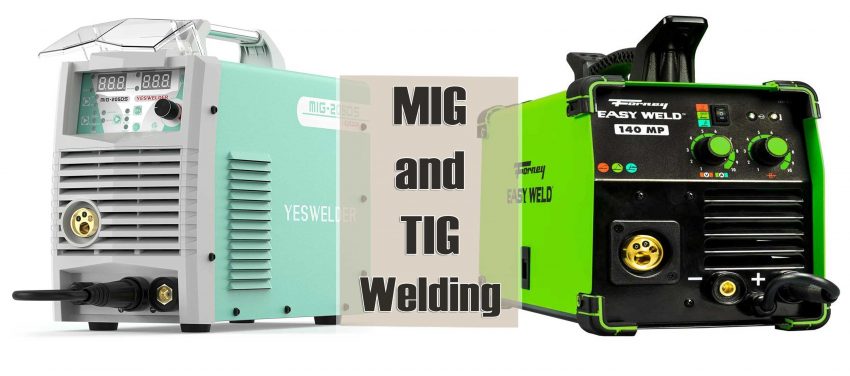MIG (Metal Inert gas) and TIG (Tungsten Inert Gas) are 2 standard welding methods in the welding industry. These 2 different techniques give you different results; knowing which type you should choose is vital.
The electrode they use to create the arc is the prime difference between MIG and TIG welding. MIG welding uses machine-fed consumable machine wire to weld. While TIG uses non-consumable electrodes.
Let’s dive deeper to learn how these 2 common welding techniques differ.
MIG vs. TIG Welding – Key Differences
Table of Contents
While TIG and MIG share a similar process, they have some key differences that make them exceptional.
| Factors | MIG Welding | TIG Welding |
| Required Equipment | Welding gun, consumable wire electrode, welding power supply, active shielding gas | Welding torch, inert shielding gas, non-consumable electrode, constant current power supply |
| Type of Electrode | Consumable electrode that is fed throughout the process without break | Non-consumable electrode that remains intact in the process |
| Material of the Electrode | Varies depending on the base material | Tungsten |
| Shielding Gas | A mixture of inert gas and active gas | An inert gas, Argon is the first choice |
| Speed | Fast | Slow |
| Spatter | It produces some spatter | TIG doesn’t produce spatter |
| Suitable for | Homogeneous welding | Homo and heterogeneous welding |
| Skill Required | Little practice required. With basic skill, MIG welding is easy | You need to be highly skilled and experienced |
| Power Source | DC | AC or DC |
Difference Between MIG and TIG Welding – In-depth Discussion
You can become better by understanding MIG and TIG welder differences. Carefully read this section.
Electrode
One of the notable differences between TIG vs. MIG is the use of an electrode.
To join 2 metal pieces, a constant fed consumable wire electrode is used by MIG. Meanwhile, TIG techniques involve non-consumable tungsten electrodes and a separate metal that performs as filler.
MIG welding doesn’t require both hands to work. But with TIG welding, you will need to hold the TIG torch in one hand and the filler metal in the other.
Holding the filler metal in one hand is a nuisance for welders sometimes. But the reality is that controlling the TIG method becomes a breeze. Also, applying the filler metal along the arc gets more precise.
Shielding Gas
The TIG welding technique uses pure argon or a mixture with shielding gas like nitrogen and helium. Nitrogen or helium are non-reactive gas that helps the method avoid contamination.
More penetration is essential in the MIG process. For this reason, it uses a mixture of argon and Co2. Thus, MIG is ideal for thick materials.
Additionally, the gas flow rate of MIG and TIG welding at which they are expelled over the torch is also different. A MIG welder’s gas flow rate is roughly 35 – 50 cubic ft./hour. In contrast, the gas flow rate of a TIG welder is 15 – 25 cubic ft./hours.
Thickness of the Welded Material
When you require welding thicker materials, MIG welding is the best option. The penetration quality of MIG welders is high. As a result, this technique is mostly used in construction sites and manufacturing pressure vessels.
TIG welder is suitable for thinner and delicate materials. Pipe joints, automotive fabrication, aerospace, etc., are the most common applications of this welding technique.
Running Time
TIG technique is shorter and ideal for technical projects. While MIG is a longer process, making it suitable for production sites. The overall cost is less in MIG welder. Also, MIG is a pretty straightforward technique.
Environment
Since both MIG vs. TIG uses shielding gas, it would be best to weld indoors with little wind.
Appearance
Many people love TIG welding for its neat and clean finish. Due to this reason, this is a common technique for ornamental and artistic purposes. In addition, MIG welding leaves a less attractive finish than TIG.
Components
Since both are different welding techniques, their components will also vary.
Some defining components of TIG welding are AC or DC power source, electrode, torch, foot pedal, electrode, backing bars, filler materials, etc.
Meanwhile, MIG welding uses a torch, conduit, gas shielding, electrode, wire, DC power for constant voltage, and filler metal to give an expected result.
Angle/Reach
Controlling a TIG welder is pretty straightforward, taking assistance from a foot pedal. TIG enables a user to weld easy-to-reach areas easily. Due to this reason, this is applicable in shop or bench work where the workpiece is positioned at a comfortable angle or reach.
MIG welder is best-suited for awkward welding areas. It is because the user has a free hand to control the workpiece.
MIG vs. TIG – Which one to Use?
Learning about your welding project can lead you to decide which one to use.
Use TIG welding, if
- You need to weld thinner materials
- You have good hand-eye coordination
- You are working with easy-to-reach angles
- You weld for shorter runs
- You are dealing with artistic or delicate projects
Use MIG welding, if
- You are welding thicker or bigger metal piece
- Your project priority is fewer defects
- You weld for longer runs
- You are a beginner
- You are working at different angles
FAQ
Is TIG harder than MIG?
TIG is much harder compared to MIG. In order to control and work with a TIG welder, there are so many things to think about to get the best result. In comparison, a MIG welder doesn’t need skill or experience. Basic welding skills allow a user to easily work with a MIG welder.
Which is better for welding aluminum – TIG or MIG?
Generally, TIG and MIG are 2 common processes for aluminum welding. TIG is the best technique for welding aluminum. The reason is that TIG lets you achieve better on lighter gauge materials. Quality weld is confirmed when you use the TIG technique.
Final Notes
After reading this comprehensive guide on the difference between MIG vs. TIG welding, you already understand that both have distinctive features and benefits. Both are used for different purposes, and you need to know your project needs to choose between these two.
MIG is easy to learn and faster. It is a low-cost and high-production technique that can weld stainless steel. TIG welders deliver clean, accurate and high-quality welds. This process is expensive, and skill is required to work with it.
Overall, consider factors like material type, quantity, component, post-processing requirements, and cost before deciding on the welding technique.

